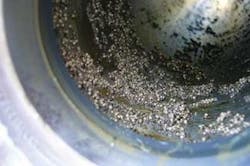Managing sand and erosive solids to optimize safety and production
Andrew Kinsler - Sand Monitoring Services
Sand management is a vaunted piece of terminology, but the safety and production implications of sand are greater than one might think. Sand is hard and often abrasive. It is defined as a detrital grain between 0.0625 mm and 2 mm in diameter, larger than silt but smaller than a granule, according to the Udden-Wentworth scale. Sand is also a term used for quartz grains or for sandstone. Furthermore, on the Mohs Scale of Hardness (range of 1-10) the major mineral constituents of sand fall in the hardness range of 7.
Since 1993 there have been at least 18 dangerous incidents on the UK continental shelf alone directly attributed to sand produced during operations. Most of these occurrences are connected to flowline failures, but a significant number are associated with production vessel and control valve failure.
Sand poses further risks through vessel deposition affecting plant performance, requiring vessel entry to dig out accumulated sand deposits. Furthermore, sand deposition can decrease corrosion inhibitor efficiency, thereby increasing corrosion and erosion.
What can be done to deal with sand and other erosive solids production, especially as the industry approaches new technological challenges? And, at what point in the field operational life cycle does sand production become an issue? This is where “sand management” comes into play.
Broadly speaking, sand management covers a range of disciplines and services that can be sub-divided into four areas of specialization:
- 1. Prediction (geo-mechanical studies)
- 2. Prevention (sand control, e.g. sand screens)
- 3. Monitoring (e.g. real time detection)
- 4. Handling (online sand removal from vessels).
More input from additional groups into the “sand network” are needed, namely integrity management and corrosion specialists and well services professionals. The consequences of sand/solids production directly impact on their work.
Although there is no single definition for “sand management,” my suggestion is “the process of identifying, evaluating, and mitigating against reservoir sand production and solids – i.e. scale and proppant – and the associated problems.” However, the industry should extend the process to all forms of erosive solids production from the wellbore throughout the life cycle of the well. In which case, Erosive Solids Management (ESM) might be more precise terminology.
When applied correctly, ESM can be an active component in production optimization. The ESM strategy (the documentation relating to the overall erosive solids management philosophy) provides a safe operating envelope in which to increase production via a controlled mechanism of sand risk assessments and active monitoring, including monitoring technology and inspection data.
It is widely accepted that certain well service operations – for example well tests – require active solids management such as solids handling systems (cyclones or sand traps) and solids monitoring. However, in terms of erosive solids it is not just sand that can be problematic. For production enhancement in tight formations, intervention techniques such as fracture stimulation employ proppant to hold or “prop” open the newly created flow paths. If the proppant becomes dislodged or the pack becomes unstable, proppant returns to surface are inevitable. These sized spherical solids entrained in the flow can cause extensive damage to flowline components.
Applying basic ESM principals of solids handling and solids monitoring would prevent incidents of highly erosive fluid streams. The technology is readily available and can be effectively implemented to reduce the risk posed by solids.
Produced solids can be detected effectively by acoustic or intrusive solids monitors. For example, a data set from a frac/clean-up operation using a combined Intrusive - Acoustic Real Time (I-ART) monitoring package constitutes an erosion probe for indicative system metal loss, with an acoustic sensor for instant response to solids production.
Data acquired from these monitoring systems can be valuable and enhances operational safety. However, to reach to the next step in the process – an ESM strategy – a greater range of information should be considered. Solids monitoring data is insufficient to implement a strategic production optimization process within an ESM strategy. It is an enabler and a key component, but it requires correlation of the solids monitoring data with production, inspection, integrity, and modeling details to add value through system integration. When this data has been analyzed, informed decisions can be taken to optimize production.
Sand champions
Following application of ESM principles, significant gains in production output can result. A proactive ESM system also requires a dedicated engineer/team within the operator to facilitate the process – i.e. a “sand champion” – acting as a focal point to gather and assimilate data needed for the optimization process within the control envelope of the ESM strategy.
In certain cases on the UK continental shelf, operators are using a Sand Risk Assessment (SRA) matrix as part of the production optimization group’s drive for production uplift through planned pressure drop programs. The SRA comprises data inputs from several sources such as current production conditions, UT wall thickness integrity data, erosion probe data, and erosion models. The net result of this data is the prediction of solids production and erosion rates at the proposed tubing head pressure (THP). The SRA represents a safety critical feature and provides a Go/No-Go stop point for the operation. An SRA cannot be issued without each criteria being met and satisfied through due process.
Key to an SRA is integration of data into a single process to systematically control operations. The solids monitoring specialist is responsible for the SRA production with designated area. Managers are responsible for issuing the SRA. On completion of any testing activity, data is analyzed and correlated with production, probe, and sampling data. From these the level of risk posed from solids production levels at the tested THP is assessed and evaluated. If the substantiated risk is within accepted values, well operating guidelines can be amended to reflect the increased production uplift conditions.
By enabling a group (or an individual) to facilitate implementation of ESM as “sand/solids champions,” a significant improvement can be achieved in safe production uplift. The benefits of this process are not reached through unique or unrepeatable process, but rather through sound engineering practices and the use of a formulaic approach.
For erosive solids management and sand control in general to move forward, there is a strong need for increased integration and correlation between disciplines. Only through this integration will we be able to grow our knowledge and improve our systems to get a real handle on issues relating to erosive solids production.
Sand strategy lifts CNS gas output
ConocoPhilips is deploying sand monitoring to coordinate all sand and erosion-related integrity issues in its central North Sea fields.
The sand management strategy has focused around gathering data sets and integrating them into a sand monitoring system using extensive knowledge of instrumentation (particularly acoustic and intrusive monitors).
The combination of this system and strategy allow control room operators to trend real-time sand probe data and therefore to respond quickly to alarm signals. A “pressure integrity management system” also has been developed, on the basis that no individual department alone could solve the problem of sand production.
A key factor was the incorporation of sand risk assessments and a production optimization process, establishing sand management as a method of increasing gas production, as well as being critical for safety.
The data control system introduces raw data output from the sand monitoring database. This enables THP (tubing head pressure) reductions as real-time, instantaneous changes could be viewed, and data analyzed in a very short time.
As a result of this strategy, the net daily increase in gas production can be tens of millions of cubic feet per day. Furthermore, the six-figure sum previously expended – and the risks associated – to mobilize staff, helicopter flights, scaffolding, and shipping has been reduced substantially with testing of wells from ConocoPhilips’ office in Aberdeen, UK.



